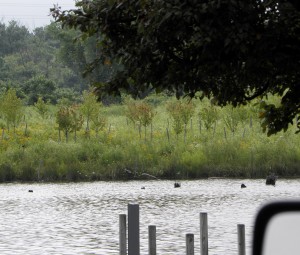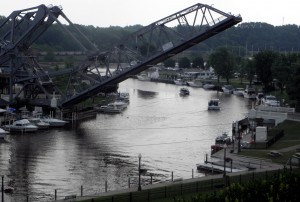Listen to the story here…

Karen Schaefer is an Ohio freelance journalist and independent radio producer.
Or follow the script:
By Karen Schaefer
ANCHOR INTRO: All across the Great Lakes region, legacy pollution from industry has tainted once vibrant rivers. Back in the late-1980’s, the Ashtabula River on Lake Erie in northeastern Ohio was classified as one of the most polluted rivers in the Great Lakes. Now 25-years later, it’s likely to become the third of the Great Lakes’ most toxic rivers to be reclassified as restored to health. As independent producer Karen Schaefer reports, it’s taken plenty of hard work and cooperation between government and industry to clean up this river — and a LOT of money.
SCHAEFER: In historic downtown Ashtabula, Fred Leitert is leading a tour of a once badly-polluted river. In one direction, toward the old lighthouse on Lake Erie, the industrial harbor is still fringed by mountains of coal. Look the other way, beyond a turn-of-the-century drawbridge, and the wide Ashtabula River is filled with small pleasure boats. You’d never guess this was a place where fish once developed tumors from invisible toxins in the river sediments.
AMBI: Sound of car turn signal, under:
FRED LEITERT: So the Great Lakes Legacy Act-funded dredging started at this bridge and went all the way up past the bridge that we’re going to.

25-thousand pounds of PCB-laden sediments were buried in this disposal site. Photo: Karen Schaefer
AMBI: Fade out under:
SCHAEFER: That other bridge is out of sight two miles away. Leitert, a retired chemical plant manager, has been working with other local residents and federal partners since the 1980’s to help clean up generations of industrial pollution from the Ashtabula.
LEITERT: This was PAH’s, PCB’s, metals — it was all in there. A good part of it came from the chemical industries, some of it from shipping and other industries.
SCHAEFER: Those sediments — enough to fill more than 30 Olympic-sized swimming pools — contained more than 25-thousand pounds of PCB’s and other contaminants so toxic they had to buried underground.
LEITERT: And this is the consolidation facility.
SCHAEFER: Wow.

Habitat restoration includes underwater fish shelves to improve breeding and new trees along river. Photo: Karen Schaefer
LEITERT: Nineteen acres of it. So from here, down to here and over there.
SCHAEFER: Lietert is pointing to a grass-covered mound, surrounded by a tall metal fence that stretches to the horizon. Over a two year-period, starting in 2006, the Army Corps of Engineers vacuumed the toxic sediments out of the river and pumped them for more than a mile to this old industrial site, where they were bagged, drained, and buried. Between the removal of the sediments, building the disposal site, and work still being done to restore habitat along the river, the price tag for this massive clean-up project is breath-taking.
FRANK LICHTKOPPLER: They spent in total, for the whole river, over 75-Million dollars.
SCHAEFER: Frank Lichtkoppler works for Ohio Sea Grant. He says it’s so far the largest such clean-up in the Great Lakes. About half the funds came from the federal Great Lakes Legacy Act. Local industries paid in more than 17-Million dollars, the Ohio EPA provided 7-Million, and local government put up the rest. Some residents objected to the cost, saying industry should be responsible. But Lichtkoppler says clean-up of the Ashtabula was a job so big no one partner could have managed it alone. And to prevent major pollution to Lake Erie, he says this work had to be done.
LICHTKOPPLER: We could deal with it in the river, but once that once that material, if it ever got flushed out into the lake, we would never be able to get it back. So we were, in a sense, racing against time – or the next huge flood that would have pushed that stuff out.
SCHAEFER: Ohio EPA division chief Kurt Princic, who helped engineer the disposal sites for sediment removal, says a cleaner Ashtabula River is already boosting the local economy.
PRINCIC: The fish population has improved and we’re seeing an increased recreational use of the river as we speak.
AMBI: sound of geese on river, run under:

Ashtabula harbor is now a busy pleasure boat port, thanks to a 75-Million dollar clean of toxic river sediments. Photo: Karen Schaefer
SCHAEFER: Near a crowded marina, Canada geese swim noisily between the boats. Downstream, fish shelves – shallow underwater banks where fish can breed — have increased spawning areas. Other restoration projects, funded through in part through the Great Lakes Restoration Initiative, are building wildlife habitat along the river’s edge. Frank Lichtkoppler of Ohio Sea Grant says fly fishermen looking for prime trout and walleye are now coming from as far away as St. Louis to fish the Ashtabula River. This summer, he says advisories against eating the fish here will finally become a thing of the past.
LICHTKOPPLER: The signs that say don’t eat the fish will soon be removed. And that’s what people have been working for decades to achieve.
SCHAEFER: There’s still one small dredging project to be finished up, but by the end of the year, most of the work should be complete. Then it’s just a matter of monitoring for a couple of years, to be sure that the Ashtabula River is cleaner and healthier than it’s been since Native Americans named it the “river of many fish.” For Ohio Public Radio/For Great Lakes Echo, I’m Karen Schaefer.
Karen Schaefer’s series on [Northeast Ohio/Great Lakes] water quality – Drink, Fish, Swim — is supported by a grant from the Burning River Foundation.